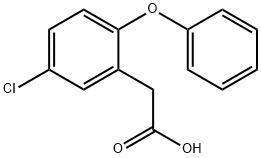The role of 5-chloro-2-phenoxyphenylacetic acid as asenapine intermediate
Schizophrenia is a relatively common mental disorder that is usually chronic in nature. There is an array of antipsychotic medications currently available, distinguishable principally by their safety and tolerability profiles, so the request to identify a particular medication that works “well enough”, is tolerated “well enough”, and that the patient is willing to adhere to [1]. Asenapine is a novel psychopharmacologic agent being developed for the treatment of schizophrenia and bipolar disorder and was approved by the US Food and Drug Administration (FDA) in 2009.
5-chloro-2-phenoxyphenylacetic acid is the intermediate of asenapine synthesis, and Marco talked about the synthesis routes starting from 5-chloro-2-phenoxyphenylacetic acid as shown in scheme 1[2].

Scheme 1 Synthesis of asenapine
The synthesis of unsaturated lactam 4 from 5-chloro-2-phenoxyphenylacetic acid 1 was considered to be well scalable, although optimization of the yields and reaction volumes was needed. The conversion of trans-lactam 5 into asenapine maleate proceeded well, however, there is the need to decrease the reaction volumes and to improve the yield of the final recrystallization was recognized. The true bottleneck for scale-up of this synthesis was found to be the conversion of unsaturated lactam 4 into trans-lactam 5.
Also, there is another literature describe the synthesis of asenapine with 5-chloro-2-phenoxyphenylacetic acid [3] as shown in Scheme 2. Both synthesis routes are similar in parts of reaction steps.

Scheme 2 Synthesis of asenapine
The condensation of labeled sarcosine methyl ester (2) (prepared from sarcosine (1) with SOCl2 and methanol) with 2-(5-chloro-2-phenoxyphenyl)acetyl chloride (3) (prepared from the corresponding acid (4) and SOCl2) yields the acylated sarcosine (5), which is cyclized by means of potassium tert-butoxide in toluene to the pyrrolidinedione (6). A further cyclization of (6) with polyphosphoric acid affords [3a-14C]-11-chloro-2-methyl-2,3-dihydro-1H-dibenz[2,3:6,7]oxepino[4,5-c]pyrrol-1-one (7), which is reduced with Mg in methanol to the trans-isomeric amide (8) (along with the cis-isomer, which is separated by HPLC). Finally, the amide (8) is reduced with LiAlH4/AlCl3 in ethyl ether and get asenapine.
references
[1] Leslie Citrome , Role of sublingual asenapine in treatment of schizophrenia, Neuropsychiatr Dis Treat. 2011; 7: 325–339.
[2] Marco van der Linden, etc., Debottlenecking the Synthesis Route of Asenapine , Organic Process Research & Development 2008, 12, 196–201.
[3] Wagenaars, G.etc., The syntheses of radiolabelled Org 5222 and its main metabolite Org 30526, J Label Compd Radiopharm 1994,34(9),845
);You may like
Lastest Price from 5-Chloro-2-phenoxyphenylacetic acid manufacturers

US $15.00-10.00/KG2021-07-13
- CAS:
- 70958-20-2
- Min. Order:
- 1KG
- Purity:
- 99%+ HPLC
- Supply Ability:
- Monthly supply of 1 ton

US $15.00-10.00/KG2021-07-10
- CAS:
- 70958-20-2
- Min. Order:
- 1KG
- Purity:
- 99%+ HPLC
- Supply Ability:
- Monthly supply of 1 ton


